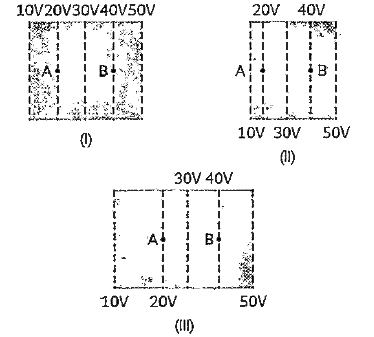A
B
C
D
Text Solution
Verified by Experts
The correct Answer is:
|
Topper's Solved these Questions
SAMPLE PAPER - 8
EDUCART PUBLICATION|Exercise Section C|6 VideosView PlaylistSAMPLE PAPER - 8
EDUCART PUBLICATION|Exercise Section C|6 VideosView PlaylistCBSE TERM-1 SAMPLE PAPER 1
EDUCART PUBLICATION|Exercise SECTION-C|6 VideosView PlaylistSAMPLE PAPER 04 (SOLVED)
EDUCART PUBLICATION|Exercise SECTION-C|6 VideosView Playlist
Similar Questions
Explore conceptually related problems
Knowledge Check
Similar Questions
Explore conceptually related problems
EDUCART PUBLICATION-SAMPLE PAPER - 8-Section B
- Same equipotential lines distributed in space are shown below. A charg...
Text Solution
|
Playing Now - Infinite number of charges of 4mu C, respectively are placed along the...
03:05
|
Play - If the conductor has V ne 0 with zero charge then:
01:46
|
Play - If two charges are kept in a material of dielectric constant what is t...
01:20
|
Play - What is the power dissipated by a bulb of 100 W - 220 V connected to a...
02:27
|
Play - Total resistance of the circuit:
05:03
|
Play - Total current flowing through the circuit:
03:52
|
Play - If number of turns in a coil is quadrupled, then self-inductance will ...
03:21
|
Play - A 1m long calculating rod rotates with an angular frequency of 400 rad...
03:21
|
Play - The current in a coil changes from 0 to 2 A in 0.05 sec. If the induce...
01:14
|
Play - When the current in a coil changes from 8A to 2A in 3xx10^(-2)s , th e...
02:01
|
Play - Lenz's law is a consequence of law of conservation of
01:24
|
Play - A soap bubble is given a negative charge, then its radius
02:19
|
Play - Select the correct statement: (I) Two field lines can not cross each...
Text Solution
|
Play - The current through a solenoid when it replaces a bar magnet A = 2 xx ...
01:10
|
Play - A circular coil expands radially in a region of magnetic field and no ...
02:27
|
Play - Voltage across an inductor, capacitor and a resistor is 30 V, 0 V and ...
02:04
|
Play - At resonance, what will be the phase difference between voltage and a ...
01:09
|
Play - When L = 2 H, C = 32 mu F and R = 10Omega , then the resonant frequenc...
Text Solution
|
Play - Assertion : In a simple battery circuit the point of lowest potential ...
01:36
|
Play
